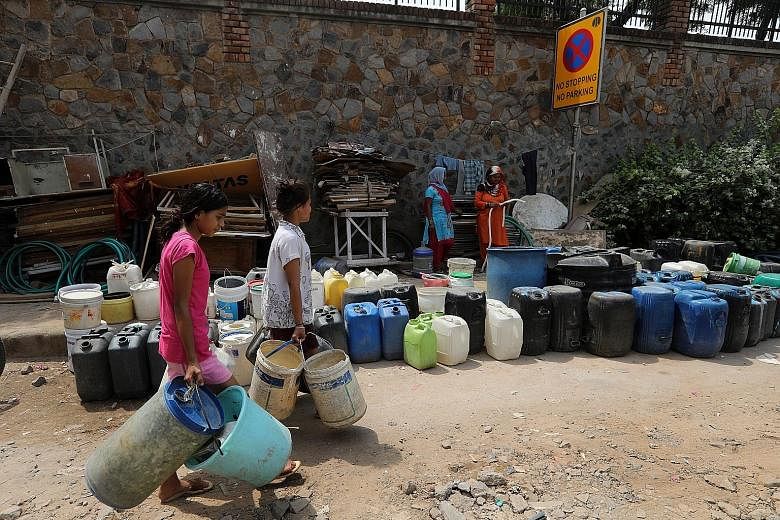A cloud of dust rises as the tanker makes its way through the unpaved track. It is a sight that brings relief to the waiting women.
With plastic hoses in hand, they stand guard over bright blue canisters all neatly in a cluster. The women cannot afford to miss their weekly ritual - stocking up on water from one of the seven government tankers that drive daily into this New Delhi slum of more than 1,000 households.
Without a piped connection, it is their only access to water.
A roster gives every household a turn - 16 households have to share 9,500 litres from each tanker.
That is little more than 590 litres for an average household of four people for a week. On days when supply is scarce, the stock has to last longer - 10 days or even longer.
In Singapore, water usage is more than 140 litres per person per day.
In India, people waiting in winding queues for water from a tanker or a public tap is not an uncommon sight. Fights over this increasingly scarce commodity are also growing, and those that lead to fatalities, worryingly recurrent.
It is a situation that could get worse, according to government think-tank Niti Aayog.

-
21
-
Number of Indian cities that could run out of groundwater by 2020.
-
25%
-
Estimated portion of sewage generated by big Indian cities that is treated, according to Mr Himanshu Thakkar, the coordinator for South Asia Network on Dams, Rivers and People.
India, it says, is facing its "worst-ever" water crisis, with some 600 million people reeling from acute water shortage.
The report, which was released on June 14 and essentially ranks states on how well they manage water, warns that demand will be twice as much as available supply by 2030, and that 21 Indian cities could run out of groundwater by 2020.
Water scarcity may also account for a 6 per cent loss in India's gross domestic product, and severely affect food security as 80 per cent of water is used in agriculture.
But how did India, a land of rivers and monsoons, reach this precipice? The problem is more a result of mismanagement than actual water scarcity, including inadequate treatment of sewage, neglect and encroachment of water bodies, and unplanned concretisation that impedes groundwater recharge.
A case in point is a Supreme Court-mandated exercise since 1994 that seeks to stop the disposal of sewage into the Yamuna river; it has yet to successfully address the problem.
"No city in India has even the adequate treatment capacity to fully treat the sewage it generates and none of the capacities that are existing is operating at given designed value," says Mr Himanshu Thakkar, the coordinator for South Asia Network on Dams, Rivers and People.
"We are possibly treating a quarter or even less than a quarter of the sewage we generate in the big cities also," he tells The Straits Times, adding that no one is taking the situation seriously enough.
This is worsened by a reliance on a model that is capital-intensive and heavily centralised, requiring sewage to be pumped over great distances and the treated water pumped back.
Long-distance transmission results in leakages, with an estimated loss rate of usable water across India of as high as 50 per cent.
Experts like Mr Thakkar are calling for a more "democratic governance" of sewage treatment with models that are decentralised and involve options such as in situ treatment.
"They (the authorities) are not trying any of these. They go for the big plants because there is much more money in these big models."
It is emblematic, he says, of a focus on investment and infrastructure, rather than sustainable development or the environment.
In Bengaluru, which has otherwise garnered attention as a city that, like Cape Town in South Africa, could run out of water, local residents have been getting their act together to offer encouraging and sustainable examples.
One such initiative is A Million Recharge Wells, which seeks to revive the city's open wells, recharge groundwater and generate community involvement to find solutions. They hope to have one well for every 700 sq m.
It is estimated that no more than 4 per cent to 8 per cent of Bengaluru's rainfall reaches its aquifers. As the city grows, further concretising its surface and choking the natural recharge system, this figure is likely to fall.
"With a proper recharge system, we can, however, increase this to around 60 per cent and replace water that we draw from the Cauvery river," says Mr S. Vishwanath, a water management expert and an adviser to the city-based Biome Trust, which is one of the organisations involved with this initiative.
The city, Mr Vishwanath argues, does not have to depend on water drawn externally "if it chooses to". Bengaluru receives around 3,000 million litres of rainfall every day and it draws 1,350 million litres externally per day.
"So, even if we manage to harvest half of the rainfall, we would be able to meet the city's need," he says.
But this is unlikely to happen as long as the authorities remain hooked on the inefficient system based on pumping water from distant reserves.
"The Bangalore Water Supply and Sewerage Board doesn't have a single hydro-geologist; groundwater just doesn't exist for them. What is needed is an institutional thrust that changes a model that remains supply-oriented to one that is in sync ecologically and socially," he adds.

